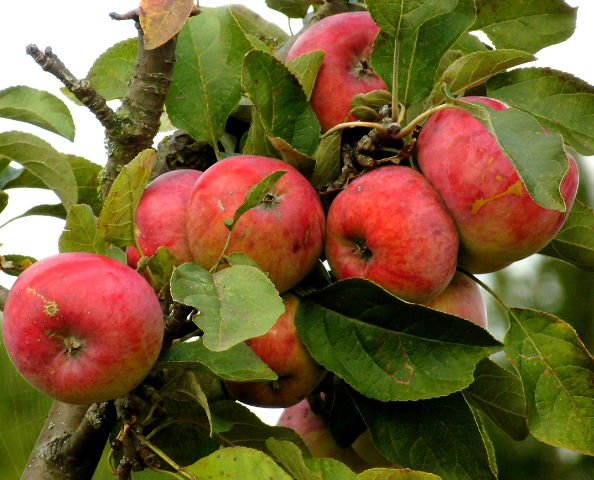Malus domestica
APFEL
Englische Bezeichnung: Apple
Spanische Bezeichnung: Manzana

Familie
Rosengewächse (Rosaceae)
Verwendbare Teile:
Frucht
Hauptbestandteile:
Mineralstoffe: Kalium
Vitamine: B-Vitamine, C
Sekundäre Pflanzenstoffe: Antioxidantien, Polyphenole
Ernte-Hinweise:
Löst sich der Apfel leicht vom Baum, ist er reif. Wenn man noch richtig ziehen muss, sollten die Früchte noch etwas hängen bleiben. Wenn man ihn aufschneidet und die Kerne leicht braun sind, sind die meisten Sorten reif für die Ernte.
Verwendung:
Salat, Gebäck, Säfte, Chutney, Strudel, Kompott, Kuchen, Bratapfel
In der griechischen Mythologie war der Fruchtbarkeitsgott Dionysos Schöpfer des Apfelbaumes. Er widmete ihn Aphrodite als Sinnbild ihrer Schönheit und Liebe. Als Urahn des Apfels gilt unter Botanikern der sogenannte Holzapfel – auch Wilder Apfel genannt – aus Zentral- und Westasien. Aus seinen sehr kleinen und herben Früchten entstanden im Lauf vieler Jahrhunderte weltweit mehrere tausend verschiedene Sorten. Die ersten kultivierten Äpfel gab es im antiken Griechenland und im alten Rom; aber erst im 16. Jahrhundert wurden Äpfel in Europa allmählich zum Volksnahrungsmittel.
Family
Rose family (Rosaceae)
Usable parts:
Fruit
Main components:
Minerals: Potassium
Vitamins: B vitamins, C
Secondary plant substances: antioxidants, polyphenols
Harvesting guideline:
If the apple comes off the tree easily, it is ripe. If you still have to pull it properly, the fruit should still be hanging a little. When you cut it open and the seeds are slightly brown, most varieties are ripe for harvesting.
Use:
Salad, pastries, juices, chutney, strudel, compote, cake, baked apple
In Greek mythology, Dionysus, the god of fertility, was the creator of the apple tree. He dedicated it to Aphrodite as a symbol of her beauty and love.
Botanists consider the so-called crab apple – also known as the wild apple – from Central and Western Asia to be the ancestor of the apple. Over the course of many centuries, its very small and tart fruits have given rise to several thousand different varieties worldwide. The first cultivated apples were found in ancient Greece and Rome, but it was not until the 16th century that apples gradually became a staple food in Europe.
Familia
Rosal (Rosaceae)
Partes utilizables:
Fruta
Componentes principales:
Minerales: Potasio
Vitaminas: Vitaminas B, C
Sustancias vegetales secundarias: antioxidantes, polifenoles
Guía de cosecha:
Si la manzana se desprende fácilmente del árbol, está madura. Si aun así tiene que tirar de ella correctamente, la fruta debe colgar todavía un poco. Cuando la abres y las semillas están ligeramente marrones, la mayoría de las variedades están maduras para la cosecha.
Uso:
Ensalada, bollería, zumos, chutney, strudel, compota, tarta, manzana asada
En la mitología griega, Dioniso, dios de la fertilidad, fue el creador del manzano. Lo dedicó a Afrodita como símbolo de su belleza y amor.
Los botánicos consideran que la llamada manzana cangrejo -también conocida como manzana silvestre- de Asia central y occidental es el antepasado de la manzana. A lo largo de muchos siglos, sus frutos, muy pequeños y agrios, han dado lugar a varios miles de variedades distintas en todo el mundo. Las primeras manzanas cultivadas se encontraron en la antigua Grecia y Roma, pero no fue hasta el siglo XVI cuando las manzanas se convirtieron gradualmente en un alimento básico en Europa.






































